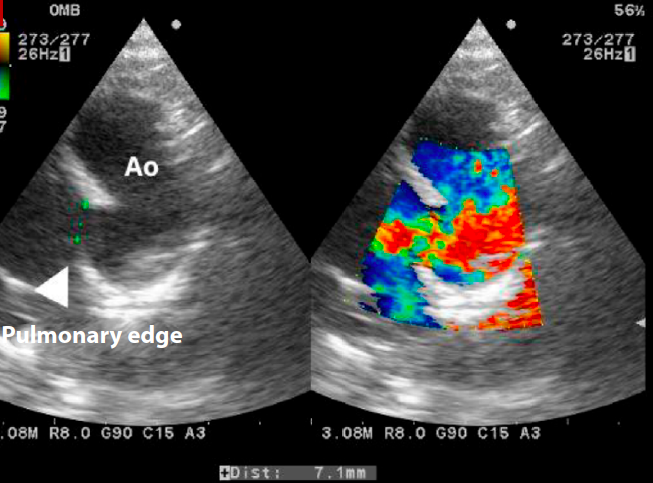Use of echocardiography in percutaneous closure of patentductus arteriosus at the Instituto Nacional de Salud delNiño, San Borja, Lima – Peru
DOI:
https://doi.org/10.47487/apcyccv.v5i2.350Keywords:
Echocardiography, Ductus Arteriosus, Patent, FluoroscopyAbstract
Objetive. Percutaneous occlusion of patent ductus arteriosus (PDA) has classically been performed entirely by fluoroscopy, however in recent years, transthoracic echocardiography (TE) has been used as an aid to fluoroscopy or entirely by echocardiography, which avoids access of femoral artery, use of contrast and decrease in time and dose of radiation exposure. The objective of this study was to evaluate the success rate with the use of TE in percutaneous PDA closure. Material and method. Descriptive, comparative, retrospective study between patients in whom PDA closure was performed with fluoroscopy plus angiography (group 1) and fluoroscopy plus ET (group 2), between January 2018 and December 2022. The data were obtained from the clinical history electronic and procedure report. Results. One hundred eight patients were analyzed, fluoroscopy group (n: 57) and TE (n: 51). The success rate in PDA occlusion using TE was 100% and 98% for the fluoroscopy group, with no statistically significant difference The average age of group 2 was 2.9 years, while the average age of group 1 was 5 years (p=0.001), the average fluoroscopy time in group 1 was 16.9 min and 4.71 min in group 2 (p < 0.001); the fluoroscopy dose in group 1 was 68.98 mGy and 5.17 mGy in group 2 (p<0.001). Krichenko, but without significant difference in both groups. Conclusions. The success rate of percutaneous PDA closure using echocardiography and fluoroscopy is appropiate, with a success rate similar to the classic technique. In addition, it makes it possible to reduce the dose and time of fluoroscopy, avoid the use of contrast, and access the femoral artery.
Downloads
References
Schneider DJ. The Patent Ductus Arteriosus in Term Infants, Children, and Adults. Semin Perinatol. 2012;36(2):146-53. doi: 10.1053/j.semperi.2011.09.025.
Attie F, Buendía Hernández A, Zabal C. Cardiología pediátrica: Diagnóstico y tratamiento. Editorial Medica Panamericana; 2000.
Olórtegui A, Adrianzén M. Incidencia estimada de las cardiopatías congénitas en niños menores de 1 año en el Perú. An Fac Med. 2013;68(2):113. Disponible en: doi: 10.15381/anales.v68i2.1221.
Stoll C, Dott B, Alembik Y, Roth MP. Associated congenital anomalies among cases with Down syndrome. Eur J Med Genet. 2015 Dec;58(12):674-80. doi: 10.1016/j.ejmg.2015.11.003.
Epçaçan S, Bulut MO, Kaya Y, Yücel IK, Çakır Ç, Şişli E, et al. Characteristics and transcatheter closure of patent ductus arteriosus in patients living at moderate to high altitude in Eastern Anatolia. Turk Kardiyol Dern Ars. 2019;47(6):431-9. doi:10.5543/tkda.2019.20805.
Ross RD. The Ross classification for heart failure in children after 25 years: a review and an age-stratified revision. Pediatr Cardiol. 2012;33(8):1295-300. doi: 10.1007/s00246-012-0306-8.
Antunes Sarmento J, Correia-Costa A, Gonçalves E, Baptista MJ, Silva JC, Moreira J. Percutaneous patent ductus arteriosus closure: Twelve years of experience. Rev Port Cardiol (Engl Ed). 2021;40(8):561-568. doi: 10.1016/j.repce.2020.09.009.
Pinto FF. Percutaneous closure of patent ductus arteriosus: A standard procedure with new perspectives. Rev Port Cardiol (Engl Ed). 2021;40(8):569-571. doi: 10.1016/j.repce.2021.07.027.
Villemain O, Malekzadeh-Milani S, Sitefane F, Mostefa-Kara M, Boudjemline Y. Radiation exposure in transcatheter patent ductus arteriosus closure: time to tune? Cardiol Young. 2018;28(5):653-660. doi: 10.1017/S1047951117002839.
Cohen S, Liu A, Gurvitz M, Guo L, Therrien J, Laprise C, et al. Exposure to Low-Dose Ionizing Radiation From Cardiac Procedures and Malignancy Risk in Adults With Congenital Heart Disease. Circulation. 2018;137(13):1334-45. doi: 10.1161/CIRCULATIONAHA.117.029138.
Pass RH, Hijazi Z, Hsu DT, Lewis V, Hellenbrand WE. Multicenter USA amplatzer patent ductus arteriosus occlusion device trial: Initial and one-year results. ACC Curr J Rev. 2004;13(10):47. doi: 10.1016/j.jacc.2004.03.074.
Wang C, Zhang F, Ouyang W, Zhao G, Lu W, Zou M, et al. Transcatheter Closure of Patent Ductus Arteriosus under Echocardiography Guidance: A Randomized Controlled Noninferiority Trial. J Interv Cardiol. 2020;2020:4357017. doi: 10.1155/2020/4357017.
Pan X, Ouyang W, Wang S, Liu Y, Zhang D, Zhang FW, et al. Transthoracic Echocardiography-Guided Percutaneous Patent Ductus Arteriosus Occlusion: A New Strategy for Interventional Treatment. Echocardiography. 2016;33(7):1040-5. doi: 10.1111/echo.13207.
Sivakumar K, Bhagyavathy A, Gnanapragasam F. Closure of Large Patent Ductus Arteriosus in Renal Failure under Echocardiographic Guidance without Use of Radiographic Contrast Media. Congenit Heart Dis. 2009;4(1):59-62. doi: 10.1111/j.1747-0803.2008.00238.x.
Krichenko A, Benson LN, Burrows P, Möes CA, McLaughlin P, Freedom RM. Angiographic classification of the isolated, persistently patent ductus arteriosus and implications for percutaneous catheter occlusion. Am J Cardiol. 1989;63(12):877-80. doi: 10.1016/0002-9149(89)90064-7.
Cao H, Chen Q, Zhang GC, Chen LW, Xu F, Zhang J-X. Clinical study of stand-alone transthoracic echocardiography-guided percutaneous occlusion of patent ductus arteriosus. Anatol J Cardiol. 2018;20(1):30-
doi: 10.14744/AnatolJCardiol.2018.90001.
Ye Z, Li Z, Yi H, Zhu Y, Sun Y, Pei L, et al. Percutaneous device closure of pediatirc patent ductus arteriosus through femoral artery guidance by transthoracic echocardiography without radiation and contrast agents. J Cardiothorac Surg. 2020;15(1):107. doi: 10.1186/s13019-020-01119-w.
Dimas VV, Takao C, Ing FF, Mattamal R, Nugent A, Grifka RG, et al. Outcomes of Transcatheter Occlusion of Patent Ductus Arteriosus in Infants Weighing ≤6 kg. JACC Cardiovasc Interv. 2010;3(12):1295-9. doi: 10.1016/j.jcin.2010.08.022.
Białkowski J, Głowacki J, Zabal C, Garcia-Montes A, Bermudez-Canete R, Flores-Arizmendi R, et al. Patent ductus arteriosus at low and high altitudes: anatomical and haemodynamic features and their implications for transcatheter closure. Kardiol Pol. 2011;69(5):431–6.
Gómez-Monroy CA, Hoyos-Gómez LK, Acosta-Costilla ÁF, Muñoz-Torres LD, Fernández-Ávila DG. Prevalence of congenital heart disease in relation to height above sea level in a region of Colombia. Arch Cardiol Mex. 2023;93(1):37-43. doi: 10.24875/ACM.21000325.
Parra-Bravo R, Cruz-Ramírez A, Víctor Rebolledo-Pineda, Robles-Cervantes J, Chávez-Fernández A, Beirana-Palencia L, et al. Cierre transcatéter del conducto arterioso persistente con dispositivo de Amplatzer en niños menores de un año. Rev Esp Cardiol (Engl Ed). 2009;62(8):867-74. doi: 10.1016/S0300-8932(09)72069-X.

Downloads
Published
Issue
Section
License
Copyright (c) 2024 The journal is headline of the first publication, then the author giving credit to the first publication.

This work is licensed under a Creative Commons Attribution 4.0 International License.














